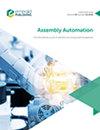基于扭量聚类模型的离散曲面结构三维公差分析
IF 1.7
4区 计算机科学
Q3 AUTOMATION & CONTROL SYSTEMS
引用次数: 2
摘要
目的提出一种新的数学模型来表示离散曲面的三维公差,并提出了一种分析具有离散曲面结构的装配公差的方法。离散曲面是由多个离散元件组成的大型面基的特殊结构,广泛应用于复杂的机电产品中。设计/方法/方法根据离散元的空间关系,用小位移量来分离离散曲面的几何特征,并对其进行表征。通过对旋量模型的积分,建立了旋量聚类模型,以表征离散曲面的积分特征变化。通过基于统一雅可比-托量法的统计公差分析,确定了离散曲面装配公差的影响和累积。通过相控阵天线的实例研究,成功地证明了该模型在离散表面综合公差表征中的有效性和优越性。基于扭体聚类模型,对公差进行了清晰直观的计算和表达。研究局限性/启示本文提出的容差分析方法对统计模拟的计算需要大量的时间和较高的计算性能。实际意义扭转体聚类模型实现了离散曲面的三维公差表示。基于该模型的公差分析方法预测了零件在物理装配前的公差累积量。原创性/价值本文提出了一种新的数学模型——扭体聚类来解释离散曲面的公差。本文章由计算机程序翻译,如有差异,请以英文原文为准。
Three-dimensional tolerance analysis of discrete surface structures based on the torsor cluster model
Purpose
The purpose of this paper is to propose a novel mathematical model to present the three-dimensional tolerance of a discrete surface and to carry out an approach to analyze the tolerance of an assembly with a discrete surface structure. A discrete surface is a special structure of a large surface base with several discrete elements mounted on it, one, which is widely used in complex electromechanical products.
Design/methodology/approach
The geometric features of discrete surfaces are separated and characterized by small displacement torsors according to the spatial relationship of discrete elements. The torsor cluster model is established to characterize the integral feature variation of a discrete surface by integrating the torsor model. The influence and accumulation of the assembly tolerance of a discrete surface are determined by statistical tolerance analysis based on the unified Jacobian-Torsor method.
Findings
The effectiveness and superiority of the proposed model in comprehensive tolerance characterization of discrete surfaces are successfully demonstrated by a case study of a phased array antenna. The tolerance is evidently and intuitively computed and expressed based on the torsor cluster model.
Research limitations/implications
The tolerance analysis method proposed requires much time and high computing performance for the calculation of the statistical simulation.
Practical implications
The torsor cluster model achieves the three-dimensional tolerance representation of the discrete surface. The tolerance analysis method based on this model predicts the accumulation of the tolerance of components before their physical assembly.
Originality/value
This paper proposes the torsor cluster as a novel mathematical model to interpret the tolerance of a discrete surface.
求助全文
通过发布文献求助,成功后即可免费获取论文全文。
去求助
来源期刊

Assembly Automation
工程技术-工程:制造
CiteScore
4.30
自引率
14.30%
发文量
51
审稿时长
3.3 months
期刊介绍:
Assembly Automation publishes peer reviewed research articles, technology reviews and specially commissioned case studies. Each issue includes high quality content covering all aspects of assembly technology and automation, and reflecting the most interesting and strategically important research and development activities from around the world. Because of this, readers can stay at the very forefront of industry developments.
All research articles undergo rigorous double-blind peer review, and the journal’s policy of not publishing work that has only been tested in simulation means that only the very best and most practical research articles are included. This ensures that the material that is published has real relevance and value for commercial manufacturing and research organizations.
 求助内容:
求助内容: 应助结果提醒方式:
应助结果提醒方式:


